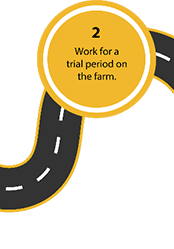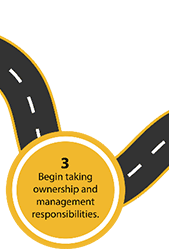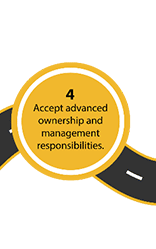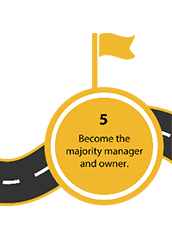The average age of U.S. and Missouri farm producers was 57 years old according to the 2017 Census of Agriculture. Yet only 17 percent of U.S. farmers, surveyed in the national 2014 Tenure, Ownership, and Transition of Agricultural Land Survey, said they planned to retire by 2019, according to the National Agricultural Statistics Service. Of the farm owners who said they are planning to retire, 53 percent have no succession plan, and only 19 percent have a successor who currently works on the farm. These data suggest that farmers struggle to adequately prepare the next generation for both farm management and farm ownership, two important components of farm succession.
Farm succession is a process that gradually accomplishes two goals:
- Readies the farm’s next generation to take farm management and ownership control
- Prepares the senior operators to transition into different on- or off- farm roles.
While farms can use a transition plan to outline how the current operator will shift ownership to another operator,1 a transition plan that does not account for how to hand off management control from the senior operator to the next generation gives the farm little chance to succeed. Farm families often overlook the management transition as they plan their farms’ future. Successfully transitioning the management of a business is complicated and requires strong communication and careful timing.
Senior farm operators who desire for their farms to continue operating successfully after they are gone need a succession plan. In the plan, you detail how to slowly prepare your successors to make decisions for all aspects of the farm business — from production to financial and from human resources to strategy — and become the farm’s primary owners and managers.
The transition process includes encouraging your farm’s successor(s) to gain the skills, knowledge and confidence needed to manage the farm business. At the same time, senior operators prepare for new roles after passing day-to-day farm management responsibilities to the next generation.
This publication outlines a five-phase process for transitioning farm management responsibilities:
- Phase 1. Successor seeks experience and education away from the farm
- Phase 2. Successor works for a trial period on the farm
- Phase 3. Successor begins taking management and ownership responsibilities
- Phase 4. Successor accepts advanced management and ownership responsibilities
- Phase 5. Successor becomes majority manager and owner





Integrating successors into the farm business
From a successor’s point of view, Figure 1 presents the five-phase farm management transition process. Think of the process as a roadmap with a destination of successors stepping into the primary farm management and ownership roles.
Phase 1. Successor seeks experience and education away from the farm
Part of running a successful business involves creative thinking and building relationships. Successors who leave the family farm for some time will gain exposure to new ideas and people. When they return, they can apply their new skills and knowledge to create opportunities for the farm business. A team from Virginia Cooperative Extension reports that farm successors working elsewhere for three years to five years puts a family’s farm transition in a better position to succeed.3
Encourage your successor(s) to get on-the-job training at another farm or business. When working away from the family farm, successors will be able to experience different approaches for completing tasks and solving problems. Additionally, successors will interact with bosses, co-workers and vendors who may become trusted mentors.
Successors ideally will seek diversified experience and exposure to perspectives throughout the value chain. For example, if a successor plans to produce row crops, then he or she could work as a grain merchandiser to learn more about commodity marketing. A successor who intends to run a cattle operation could work at a feedlot to discover what buyers want in feeder cattle. Learning non-farm skills like accounting or supervising people can be helpful. A successor who gains broad off-farm experience will be more prepared to manage the family farm.
Educational programs can also build knowledge and skills. For example, a successor may consider pursuing a degree at a vocational school or university. Industry seminars, field days and extension courses can teach important concepts that successors can bring back to the farm. Joining a professional organization or peer group can also offer opportunities to build a network and learn.
Phase 2. Successor works for a trial period on the farm
Next, hire farm successors as paid employees. During this time, establish clear expectations for successors through written job descriptions, employment policies and business agreements. These tools add formality to the work arrangement. Staffing agency Robert Half suggests allowing successors to rotate through different jobs to develop breadth of experience.4
Treat this trial period as a “test.” For the work arrangement to succeed in the long term, senior operators and successors need to feel comfortable and collaborate well. The trial period also offers a chance to see how well senior operators and successors can keep family and business matters separate — an essential priority for all family businesses.
Often, farms allocate one year or two years to the trial period. You must set a planned end date and treat it as a deadline. Complete an honest two-way evaluation when the trial period concludes. During the evaluation, the senior operator should assess a successor’s fitness to run the farm. A successor should reflect on whether the senior generation respects the next generation and appears committed to relinquish control when the succession process ends.
If the trial exposes problems, then consider how to correct them. Ultimately, decide whether the successor will transition to the next succession phase or choose to exit the business. The key is to make a decision and not let this phase continue in perpetuity. Failing to move past this phase pegs a successor as an employee instead of recognizing the successor as a next-generation farm owner and manager.
When making decisions about whether a successor continues to the third succession phase, do not force the arrangement. In circumstances where a successor is a family member, the family tie alone should not guarantee a role on the farm. The goal is to build a harmonious business relationship.
Phase 3. Successor begins taking management and ownership responsibilities
At this phase, designate a farm enterprise or function that your farm’s successor(s) will manage. Give successors the responsibility and authority to make at least some decisions for the assigned enterprise or business function. Many successors report they learn more and feel more empowered if they have an opportunity to make decisions.
Think creatively when identifying an enterprise or function for successors to manage. For example, row crop producers may consider letting the successors manage one rented farm. Cattle producers may assign one enterprise, such as heifer development, to a successor. In terms of business functions, successors could have marketing or human resources management responsibilities delegated to them.
In addition to gaining management responsibilities, successors should begin to own farm assets at this phase. Farms may choose from several strategies to allow successors to buy or earn assets. Consult with an experienced agricultural attorney and accountant as you evaluate asset transfer options, including developing an estate plan.
Ownership allows successors to participate financially in the business. With an ownership stake, successors also may feel more committed to the farm business because they see a connection between owning assets and building their future. Plus, successors may feel more comfortable with borrowing money needed for financing farm investments when they already own some assets. The lending process would acquaint successors with how to work with bankers and plan for how to repay a loan.
In some cases, farms with low profitability feel challenged to adequately compensate successors for what they contribute to the business. However, appreciating assets such as land can create wealth, and offering an ownership stake in such assets can serve as a form of compensation.
Phase 4. Successor accepts advanced management and ownership responsibilities
By this phase, your farm’s successor(s) should take full responsibility of one farm enterprise or business function. If a successor will run the farm’s beef business, for example, then ensure the successor understands not only the production factors but also the finances, purchasing requirements and marketing responsibilities.
Farm succession has the potential to fail at this stage if the successors do not assume complete control of a business enterprise or function. Often, senior farm operators hesitate to allow their successors to manage the finances. For a farm to have long-term financial viability, however, the successor(s) must develop an aptitude for managing costs, returns and investments. Therefore, the succession process must provide those types of skill-building opportunities for successors.
Phase 5. Successor becomes majority manager and owner
The fifth and final phase of the succession process is when farm successors take a majority position in managing and owning the farm business. By holding a majority stake, successors make most of the business decisions.
Transferring the ownership of assets can be complicated for large farms and different strategies have different tax implications. Separating operating assets, such as livestock and machinery, from land ownership may be necessary. As noted above, families should always consult with an experienced lawyer and accountant to explore options. However, an advantage to asset transfer before death is that the next generation has the certainty of knowing they are investing in a future they own, and not relying on phrases such as, “This will all be yours someday.”
Preparing senior farm operators for a new role
A successful farm transition should not only focus on the successors. At each succession phase, senior operators take responsibility for fewer day-to-day decisions and tasks. By the fifth phase, the senior generation no longer will serve as the farm’s chief executive. Therefore, senior operators should use the five-step management transfer process as an opportunity to not only groom successors but also prepare themselves for what is next.
This transition may be difficult. Research from Ireland documents how farmers may fear handing over decision-making control because they feel their identity and societal status will then change. They view their on-farm work and authority as “symbolic capital” — emblems that represent what they have achieved and that mark their place in the world.5
To senior operators, retirement may mean losing symbolic capital they have accumulated. Plus, they may miss the opportunity to accrue more of that capital into the future.
Senior farm owner-operators often choose one of two pathways when their successors assume primary control of the business: withdraw from the farm or serve as a mentor and adviser.
Withdrawal
After successors become majority managers and owners, some senior farm operators may choose to detach completely from the farm business. Think about whether you have dreams to relax, travel, spend time with family, volunteer, pick up a new hobby or start a business. If you have many retirement ambitions, then complete withdrawal may ensure you have enough time and capacity to pursue all of your goals.
Mentorship
For senior operators who want to continue contributing to the farm business after successors take the reins, they may serve as farm mentors. When mentoring, think of the farm as a team competition, not an individual sport. You will not call all the shots or participate as the star player. However, you can make meaningful contributions as a coach who can offer advice based on your years of experience.
As a mentor, give your successor(s) the space to learn and make mistakes. Your encouragement and support can help your successor(s) problem-solve. The focus should be helping successors succeed.
Keep in mind what your presence may still mean to others on the farm. Although you have transitioned management responsibilities, some farm employees or family members may struggle to see you as a helper instead of the boss, explains family business consultant Dick Wittman. To signify you’re no longer the chief executive, Wittman suggests moving to a new office or arriving to work after operational meetings have concluded.6
Wittman recommends adding some formality to the mentorship relationship. For example, senior mentors and successors can schedule coaching sessions. To make these sessions count, mentors should be clear about what farm information they need to provide the best input. Also, treat these sessions as opportunities to help successors arrive at decisions, not tell them what to do.6
Give them the best chance to be successful
Transitioning a family farm business from one generation to the next is complicated and can easily overwhelm a family. That is why 53% of farmers planning to retire do not have a succession plan, and only 19% currently have a successor working with them on the farm. If a farmer wants their legacy to continue, they need to develop a roadmap for the next generation to develop the skills and abilities to be successful. Farm succession should be viewed as a multi-year process with evaluation milestones for both senior operators and successors. The roadmap described above helps the senior generation develop a plan for how their roles will transition as their successor assumes more responsibility. Starting these conversations as a family and completing the accompanying worksheet to plan for your family farm will give the next generation the best chance of being successful.
Sources
- Land for Good. “The Farm Transfer Process (PDF).”
- Schurle, Bryan, Rodney Jones, and Duane Hund. 2012. “Transition Planning: 12 Steps to Keep the Family Farming.” Kansas State University, November 2012.
- Kohl, David M. et al. 1996. “Ten Rules of Transition Management.” Virginia Cooperative Extension, June 1996.
- Robert Half. 2021. “What Is Succession Planning? 7 Steps to Success.” The Robert Half Blog, October 3, 2021.
- Conway, Shane Francis et al. 2016. “Cease agricultural activity forever? Underestimating the important of symbolic capital.” Journal of Rural Studies 44, April 2016: 164-76.
- Farm Marketer. 2022. “Getting Out of The Way Without Going Away (with Dick Wittman).” Farm Marketer, Episode 160, Feb. 2, 2022.